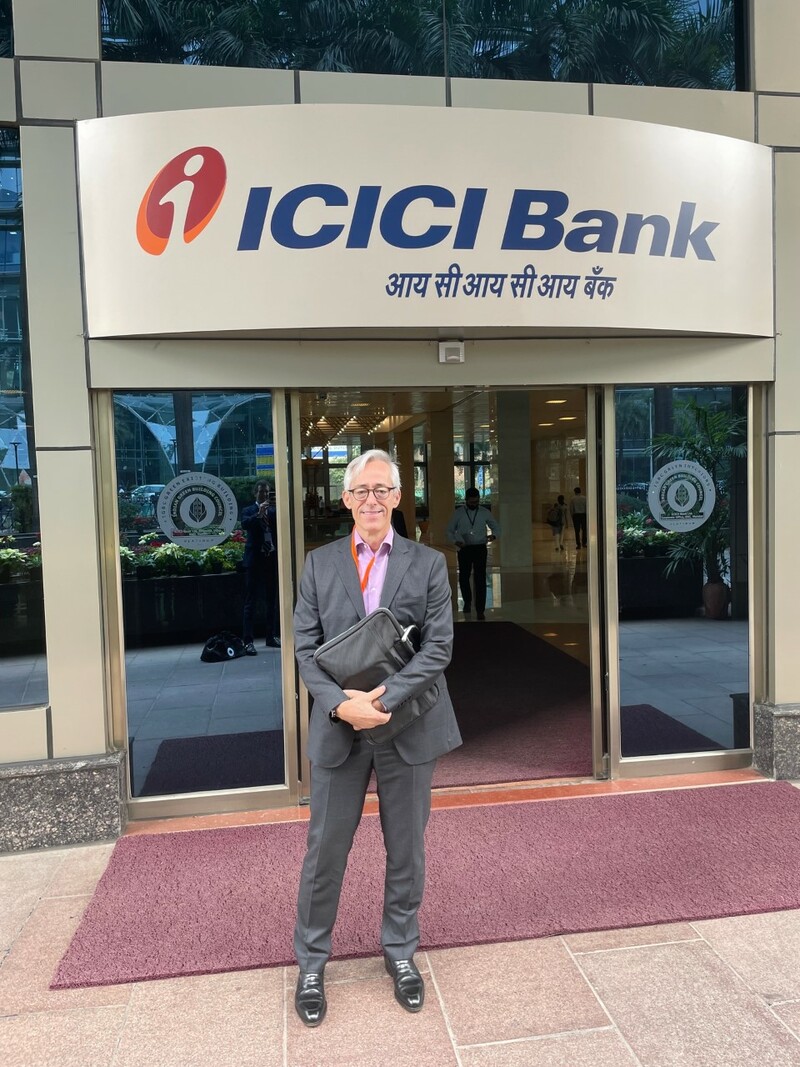Early December, we spent one week in India (Mumbai, Delhi and Lucknow, Uttar Pradesh) visiting companies in their head offices.
In Mumbai, we met CEO/CFOs of State Bank of India, ICICI Bank and its subsidiary ICICI Pru, HDFC and its bank unit HDFC Bank. The three banking groups experiment a vigorous loan demand and should be able to thrive in a new credit cycle fueled by a new property cycle (doubling of Real Estate sector contribution to GDP from 7% now to close to 15% in 2026, improving affordability). Their Non Performing Loans start at a low level and show so far no signs of deterioration despite rising interest rates. Meanwhile Net Interest Margins may see some erosion as deposit rates are being repriced at higher level . For example, HDFC Bank has increased deposit rates by 210bp from the bottom, now at a 3-year high (7% in the 1-3-year bucket). Note that Indian Central Bank RBI has hiked repo-rate by 225bp from the bottom. Overall loan as well as EPS growth is expected to reach 20% pa in next 2 years. ROA is expected to remain at 2%. P/BV is not cheap though (2.8x for both ICICI Bank and HDFC Bank). We remain excited by the prospect of the sector (5% of GemEquity) and prefer the private entities such as ICICI and HDFC to State Bank of India of which Tier1 capital seems a bit low. The merger between HDFC Bank and its holding company HDFC (specialized in morgages and property developers loans) has been proceeding faster than expected and sources of synergies are plenty. HDFC reminded us that current mortgage penetration is very low at just 11%. With 2/3 of population under 35, there is a massive demand pool coming. We also met India's largest E&C company Larsen & Toubro (active in India as well as in the Middle East), Birla Group (largest cement producer through subsidiary Ultratech, largest aluminium producer through Hindalco), Asian Paints (largest paint manufacturer in sub-continent), Marico (FMCG manufacturer, leader in coconut oil, edible oil and value added hair oil), Maruti Suzuki (45% m/s in Indian passenger vehicle market) and Indian Hotels (owner of the famous Taj Group of Hotels, part of Tata Group). In Delhi/Noida, we met key executives of Max Healthcare (one of the most dynamic hospital chain in India), Dabur (ayurvedic product specialist), Dixon Technologies (manufacturer of consumer electronics, home appliances and smartphones) and of new economy leaders Delhivery (logistics platform) and Zomato (food ordering and delivery platform). Last but not least, we visited Biba (women clothes) and Tanishq (Titan jewelry name) stores.
. For example, HDFC Bank has increased deposit rates by 210bp from the bottom, now at a 3-year high (7% in the 1-3-year bucket). Note that Indian Central Bank RBI has hiked repo-rate by 225bp from the bottom. Overall loan as well as EPS growth is expected to reach 20% pa in next 2 years. ROA is expected to remain at 2%. P/BV is not cheap though (2.8x for both ICICI Bank and HDFC Bank). We remain excited by the prospect of the sector (5% of GemEquity) and prefer the private entities such as ICICI and HDFC to State Bank of India of which Tier1 capital seems a bit low. The merger between HDFC Bank and its holding company HDFC (specialized in morgages and property developers loans) has been proceeding faster than expected and sources of synergies are plenty. HDFC reminded us that current mortgage penetration is very low at just 11%. With 2/3 of population under 35, there is a massive demand pool coming. We also met India's largest E&C company Larsen & Toubro (active in India as well as in the Middle East), Birla Group (largest cement producer through subsidiary Ultratech, largest aluminium producer through Hindalco), Asian Paints (largest paint manufacturer in sub-continent), Marico (FMCG manufacturer, leader in coconut oil, edible oil and value added hair oil), Maruti Suzuki (45% m/s in Indian passenger vehicle market) and Indian Hotels (owner of the famous Taj Group of Hotels, part of Tata Group). In Delhi/Noida, we met key executives of Max Healthcare (one of the most dynamic hospital chain in India), Dabur (ayurvedic product specialist), Dixon Technologies (manufacturer of consumer electronics, home appliances and smartphones) and of new economy leaders Delhivery (logistics platform) and Zomato (food ordering and delivery platform). Last but not least, we visited Biba (women clothes) and Tanishq (Titan jewelry name) stores.
Country Economic Focus :
During the trip, we also met Dr V Anantha Nageswaran, Chief Economic Advisor to the Government. Dr Anantha explained to us that numerous reforms put in place in the last 5 years (bankrupcy law, real estate rehabilitation code, GST, massive financial inclusion post demonetisation and United Payments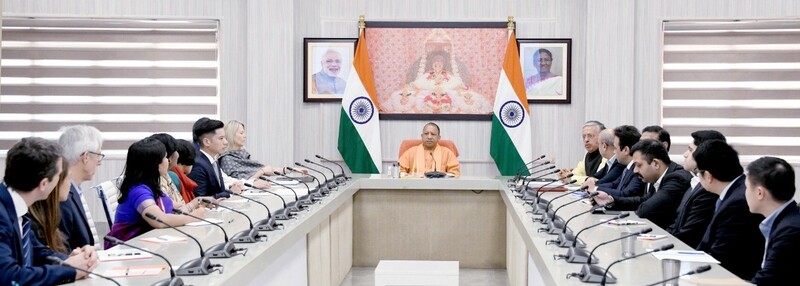 Interface implementation) have added around 100bp to the GDP structural growth rate. In addition, the property sector after an extended period of stress (collapse of Non Banking Financial Company IL&FS in 2018) seems a lot healthier now with much lower level of debt. An upcycle there fuels growth in the economy. Last, the manufacturing sector is expected to be boosted by various state subsidies including the PLI scheme (Production Linked Incentive Scheme). Taking all these factors into account, structural growth could reach 12% nominal, 7% real pa in the next 5 years. In the shorter term however, higher oil price, inflation and interest rates rise are headwinds. Rural demand is affected by inflation, but this one is slowing. RBI has hiked repo-rate by 225bp from the bottom and is expected to continue its tightening mode up until mid 2023. However, growth enablers are in place with improved balance sheet for banks and the corporate sector. Towards the end of 2023, election related spending (general elections scheduled in mid-2024) is likely to fuel rural consumption.
Interface implementation) have added around 100bp to the GDP structural growth rate. In addition, the property sector after an extended period of stress (collapse of Non Banking Financial Company IL&FS in 2018) seems a lot healthier now with much lower level of debt. An upcycle there fuels growth in the economy. Last, the manufacturing sector is expected to be boosted by various state subsidies including the PLI scheme (Production Linked Incentive Scheme). Taking all these factors into account, structural growth could reach 12% nominal, 7% real pa in the next 5 years. In the shorter term however, higher oil price, inflation and interest rates rise are headwinds. Rural demand is affected by inflation, but this one is slowing. RBI has hiked repo-rate by 225bp from the bottom and is expected to continue its tightening mode up until mid 2023. However, growth enablers are in place with improved balance sheet for banks and the corporate sector. Towards the end of 2023, election related spending (general elections scheduled in mid-2024) is likely to fuel rural consumption.
We also spent one day in Lucknow, capital city of Uttar Pradesh. Uttar Pradesh is the most populous state in India with 230M inhabitants, the largest producer of agriculture products and also one of the poorest state. It is the 3rd largest state economy in India and contributes 8-10% of national GDP ($330bn). Its GDP per capita has grown 20% pa in last 5 years. We had the chance to meet State Chief Minister Shri Yogi Adityanath, who is a key person in the BJP apparatus. Shri Yogi is mentionned to be the successor of Prime Minister Modi after his third term. His aim for the state is to develop infrastructure (airports, highways, inland waterway) to attract companies and eventually reach $1tr for the state economy (x3 from now).
Focus : A new cycle has just started : better affordability - low inventory
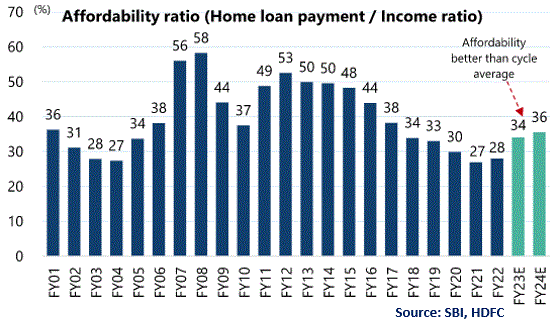
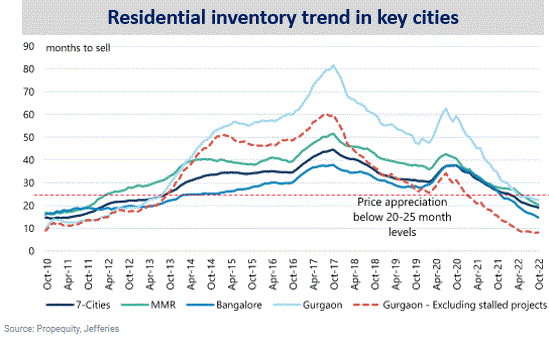
ESG Country Focus : Climate Targets - Where does India stand ?
India's contribution towards historical GHG emissions (1850-2019) is ~4% despite ~17% share of global population, given its nascent stage of economic development. As a result, India has used a small part of its fair share in the global carbon budget. Per data from Global Carbon Project, India 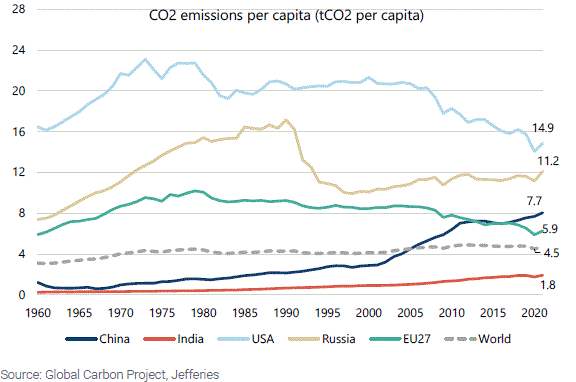 is the third-largest carbon emitter currently (behind China and USA), with total emission of 2.7GtCO2 (~8% share of global emissions) recorded in 2021. However, on a per capita basis, India's emission is ~60% below the global average. The country has committed to three targets to reach its net zero goal: 1/ Lower emission intensity of its GDP by 45% from 2005 levels by 2030; 2/ Achieve 50% cumulative non-fossil fuel based generation capacity by 2030; and 3/ Create additional carbon sink of 2.5-3 GtCO2 eq via additional forest and tree cover by 2030. India achieved a 24% reduction in emission intensity between 2005 and 2016 (based on UNFCCC submissions) and remains on track to reach its target of 45% reduction by 2030. Its installed capacity from non-fossil fuel based generation (incl. hydro) stood at 157GW or ~40% of total installed generation capacity as of March 22. The renewable capacity (ex. hydro) has grown at a ~16% CAGR over the last decade, led by rise in solar-based generation capacity. Capital subsidies, lower corporate tax rates, and import duty protection have been put in place for manufacturers. Easier access to capital and capital subsidies in renewable transmission networks have been put in place for generators, and purchase obligations have been instituted for suppliers. For consumers, regulations to lower renewable power cost and provide capital subsidies have been instituted.
is the third-largest carbon emitter currently (behind China and USA), with total emission of 2.7GtCO2 (~8% share of global emissions) recorded in 2021. However, on a per capita basis, India's emission is ~60% below the global average. The country has committed to three targets to reach its net zero goal: 1/ Lower emission intensity of its GDP by 45% from 2005 levels by 2030; 2/ Achieve 50% cumulative non-fossil fuel based generation capacity by 2030; and 3/ Create additional carbon sink of 2.5-3 GtCO2 eq via additional forest and tree cover by 2030. India achieved a 24% reduction in emission intensity between 2005 and 2016 (based on UNFCCC submissions) and remains on track to reach its target of 45% reduction by 2030. Its installed capacity from non-fossil fuel based generation (incl. hydro) stood at 157GW or ~40% of total installed generation capacity as of March 22. The renewable capacity (ex. hydro) has grown at a ~16% CAGR over the last decade, led by rise in solar-based generation capacity. Capital subsidies, lower corporate tax rates, and import duty protection have been put in place for manufacturers. Easier access to capital and capital subsidies in renewable transmission networks have been put in place for generators, and purchase obligations have been instituted for suppliers. For consumers, regulations to lower renewable power cost and provide capital subsidies have been instituted.
Company Focus : Indian Hotels Co Ltd. Sales : $700M - Market Cap. $5.7bn
Part of the Tata Group (36% stake), Indian Hotels Co is the largest Indian hospitality company with offerings across sub-segments such as hotels, 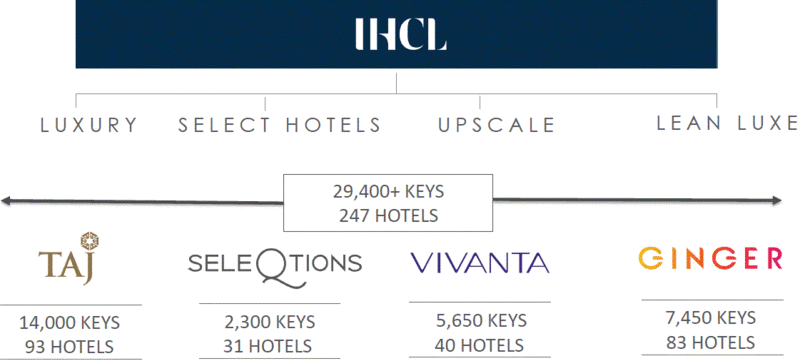 homestays, restaurants, banquets and air catering. It owns key brands such as Taj, SeleQtions, Vivanta, Ginger, Ama, Chambers and Qmin. The group manages 247 hotels and opens 1.5 properties per month. Total number of rooms is 21,100 o/w 15% are abroard and 85% in India.
homestays, restaurants, banquets and air catering. It owns key brands such as Taj, SeleQtions, Vivanta, Ginger, Ama, Chambers and Qmin. The group manages 247 hotels and opens 1.5 properties per month. Total number of rooms is 21,100 o/w 15% are abroard and 85% in India.
CEO Puneet Chhatwal and CFO Giridhar Sanjeevi expect demand for branded hotel rooms, which is just 5% of India's total 3.3M hotel rooms to see a 12% CAGR (GDP multiplier of 2x). He expects the average room rate (ARR) to continue to surge over the next few years.
rate (ARR) to continue to surge over the next few years.
The group strategy focus on 4 key pillars : 1/Reaching a total of 300+ hotels across the portfolio; 2/Reaching a consolidated EBITDA margin of 33% in 3 years (from 20-25% now) with 35% of EBITDA from management contracts and new businesses; 3/Achieving a 50:50 ratio between owned/leased and management contract room keys and 4/Retaining a net cash balance sheet.
Company continues its efforts to leverage its existing brand equity in its new business segments, to focus on cost optimisation asset light management contract model to expand room portfolio while maintaining its net debt free balance sheet. The pipeline (up until 2027) includes 65 hotels (8,300 rooms), fuelling a CAGR of 7% in the number of rooms. Management sees its upper midscale hotel brand, Ginger, as the next driver of growth for the company. I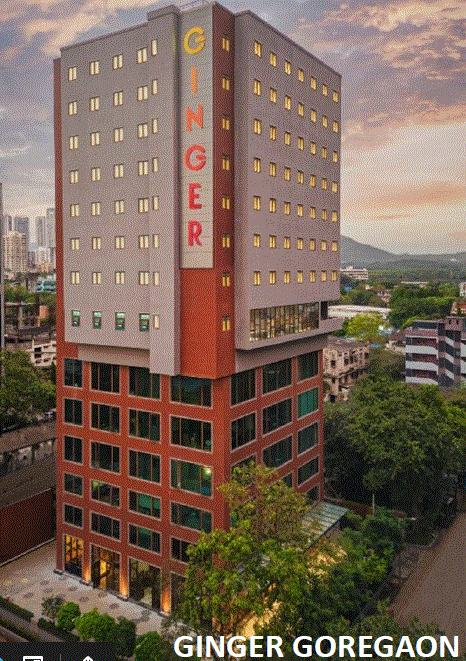 t has planned meaningful room inventory additions, and believes upgrades to the lean luxe model can help in terms of room rates.
t has planned meaningful room inventory additions, and believes upgrades to the lean luxe model can help in terms of room rates.
As per management, the occupancy and room rates seen so far this quarter (seasonaly one of the strongest quarters) indicate that RevPAR grows at double digits vs. similar period seen pre-COVID. The revenue continues to be driven largely by higher ARRs and a demand-supply gap. Looking at next year, management pointed to some of the possible levers including the potential recovery of inbound international tourism, which should be strongly positive for earnings. Inbound international tourism used to contribute almost 30-35% of its total revenue. As of now, it is still far from a full recovery. Management believe that it has recovered only about 50-60% of pre-COVID levels. An additional fillip to demand over the medium term may be India holding the G-20 presidency from December 22 to November 23. Last but not least, the ICC Cricket World Cup will be hosted by India in Oct-Nov 2023.
At industry level, medium term outlook remains strong, well supported by a favourable demand-supply equation. Capacity is expected to increase by 5% pa over the next few years, primarily from the conversion from non-branded to branded, which means the real capacity growth could be even lower. Capacity increase is constrainted by high cost of construction.
From a financial standpoint, we expect the company to generate annual FCF (post capex) of around 150M$ each year in the next 3 years. While a portion of this may be distributed, utilisation of FCF to enhance return ratios will be key to monitor. As of September, the company is net cash (50M$). Brand value, net cash and the Tata management make the stock trades at a high multiple (27x EV/EBITDA). We would be buyer on weakness.
